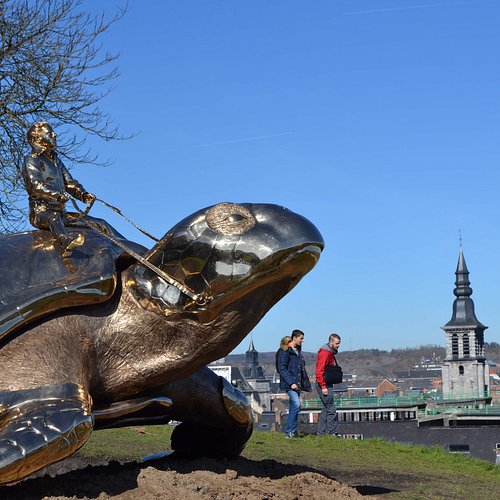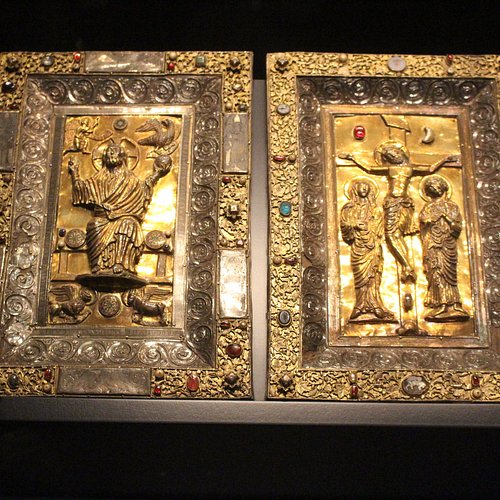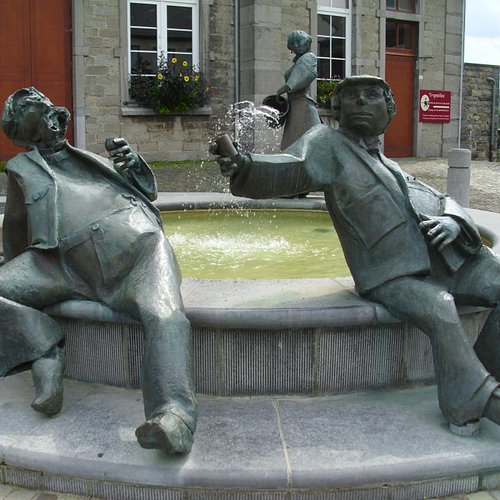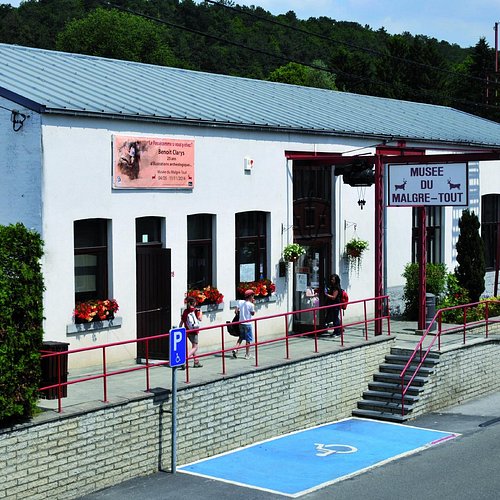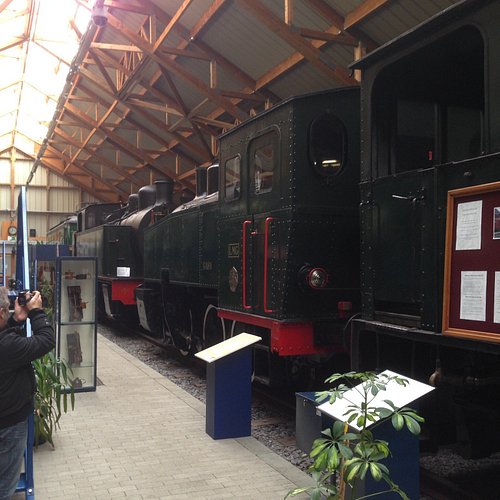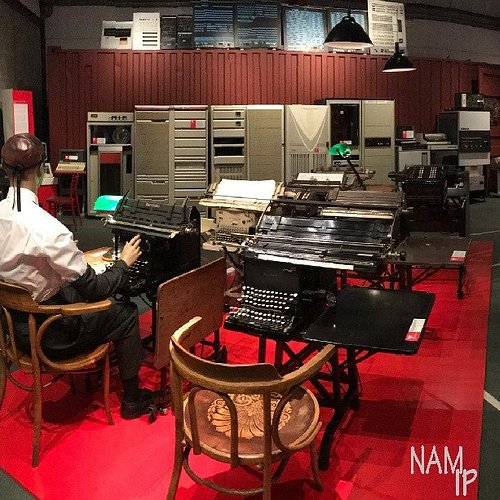Top 10 Specialty Museums in Namur Province, Wallonia
Discover the best top things to do in Namur Province, Belgium including Ecomuseum of the Viroin, Felicien Rops Museum (Musee Felicien Rops), Tresor d'Hugo d'Oignies, Maison Du Patrimoine Medieval Mosan, Espace Arthur Masson, Musee du Malgre-Tout, Bister, Musee du Chemin de Fer a Vapeur, Computer Museum NAM-IP, Chateau de Bioul.
Restaurants in Namur Province
1. Ecomuseum of the Viroin
Overall Ratings
5.0 based on 4 reviews
In a magnificent 16 century farm castle, the Ecomuseum of the Viroin is a link between past, present and futur. The museum focuses on the social and economical history of the beautiful Entre-Sambre-et-Meuse region. It tells the story of men and women, craftmen, farmers and villagers...
2. Felicien Rops Museum (Musee Felicien Rops)
Overall Ratings
4.5 based on 251 reviews
Reviewed By periandro - Luxembourg City, Luxembourg
The building inside which there is the Museum is a nice house dating back to the seventeenth century situated in 12, rue Fumal to where it moved in the eighties of the twentieth century from the Hôtel de Gaiffer d’Hestroy. The Museum is located in the hub of Namur at a walking distance from the Cathedral. That can be clearly realized by casting a glance through the two looking boxes directed to Saint - Aubain Cathedral and St. Jean church, very interesting views by the way. The works by Rops displayed in that Museum represent a unique art conception encompassing divers types of slide arts. So, one can see there some lithographs which were published in the Uylenspiegel journal, such as the caricature of the French photographer Nadar and “La politique pour rire”. It’s amazing to realise how in the satirical drawings concerning the series to which the last mentioned lithographs belong Rops referred to the Belgian constitution and blended humour with parliamentary decisions. The “Uylenspiegel , journal des débats, artistiques et literaires” was a magazine founded by Rops himself and therefore the real starting point of his artistic career. His art production at that time wasn’t constricted to lithographs and the proof thereof is the oil painting “L’Entrée au bal”. It’s a striking picture in that Museum at the sight of which it’s easy to gather that Rops’s concerns didn’t fall within the academic teaching which enjoined geometric rigour and perfect identification of forms. Likewise the lithograph “La Médaille de Waterloo” is a striking work particularly as it depicts the army as a mass of absurd skeletons. This work is an example of Rops’s political commitments as it shows a dwarf senile Emperor supporting himself with a cane in the middle of a radiant Waterloo medal . “La Peine de Mort” is also a witness of the author’s political commitment as a contribution against death penalty. In his works within the scope of realism style the denouncement of the hypocrisy of certain people is outstanding. In them Rops painted what he saw. That’s why he was accused sometimes of making anticlerical works, as it was the case in connection with “Chez les Trappistes” and in “Un Enterrement en Pays Wallon”. Both litographs are eye catching as they denounce the perversity and the stupidity of the clergy respectively. The latter should be observed attentively in order to realise the solitude in which the little orphan in front of the grave finds himself as he doesn’t get a single gesture of consolation or tenderness from the other people attending the burial. The painting “Tête de Vieille Anversoise” is in realism style. In it the piercing and scrutinizing gaze of the elderly lady depicted in it is somewhat terrifying. Among Rops’s works somehow related to the French poet Charles Baudelaire exhibited in the Museum one could point out “La Mort qui danse”, “Les Épaves”, consisting in etching and dry-point, destined to be the frontispiece for Charles Baudelaire’s work “Les Épaves”, and “Satan semant l’ivraie”. The last one depicts a frightening scene in which the devil tramples on a freshly ploughed soil spreading away the rye grass that will destroy the farmers’ harvest. Rops was also very skilled in the technique of engraving what can be observed in two sketches exhibited in the Museum which he made to be used as a frontispiece for “Les Oeuvres Inutiles et Nuisibles” 1879 - 1880 consisting of two albums, the first one opening with a naked woman and the second album with the same drawing on the same woman dressed in her city dress. It’s amazing to watch these two drawings which somehow remind of the paintings of the Majas by Goya. Perhaps the most interesting sections of the Museum are the works having women as the main character. In the works included in one of those sections some prostitutes are portrayed as well as scenes in women’s bars, cabarets and brothels. The world of prostitution really fascinated the artist. That section consists of drawings, heliogravures prints, pastels and colour etchings. All the women represented in those works are beautiful as one can see in the following ones: “La Buveuse d’Absinthe”, “La Dèche”, “Le Gandin Ivre” and “Le Bouge à Matelots”. In another section Rops tried to reflect the fact that at the end of the nineteenth century women were often considered as manipulating. The charming character of all women depicted in those works is outstanding. Watching them one can be astounded at realising that women possess whatever is needed to procure for themselves all that they want from men. This can be clearly observed in Rops’s versions of “Dame au Pantin et à l’Éventail”, made each one of them using different techniques though the watercolour is present in all of them. In the fourth version, for instance, the lady carries a knife on her belt and, with a satisfied expression, holds up a puppet whose position calls up its submissive role. The picture “Pornocratés” ou “La Dame au cochon” is perhaps Rops’s most widely known work. It’s a stunning work depicting a lady dressed only in gloves, black stockings and a Gainsborough hat who walks proudly over the ancient arts that are sculpted and set into the marble. Three little cherubs try to seduce the woman, who continues its way guided by a pig. It’s a marvelous painting. Upon suggestion of Jules Noilly, Rops created more than a hundred sketches of lifestyles outlining the bourgeois hypocrisies of the time. In the Museum there are about twenty of them which are splendid artworks that can no doubt be admired by anyone having a bit of sensitiveness. One among the most interesting of them is perhaps “La Chanson de Chérubin” representing a scene in a boudoir saturated with red. That scene is about a vulgar bourgeois singing a serenade to a prostitute who has a vague look and is undressed. Another precious picture of that series is that called “La Toilette” showing a woman of doubtful reputation and morals dressing herself under the interested gaze of a dandy, lacing her corset, her eyes riveted on those of her lover. She reveals herself to be manipulating and dangerous. In the journeys that Rops made to evade himself from Paris and so discover other realities, he also continued carrying out his artistic activity. The most outstanding artworks displayed in the Museum in relation to those intervals are the oil on canvass paintings “La Plage de Heyst”, which is the impression of the atmosphere of a visit to the North Sea, and “Le Paysage Scandinave” in which he used a post-impressionist technique, as well as that called “Vue de Séville”. As far as the rest of the works to be admired in the Museum is concerned, that painting called “Avendre (Les Deux Amies)” is the most outstanding. It depicts two ladies, one of them consisting of a stunning nude comparable to those of Toulouse-Lautrec. Besides, on the day I visited the Museum, 14.01.2020, the temporary exhibition was also very interesting. It consisted of paintings borrowed from other Belgian museums and included even one by Ensor. As one can gather from the foregoing the Rops Museum is a unique art museum housing highly valuable works different from those which can be seen in most museums. Such works are both very peculiar and beautiful. In order to realize such qualities it’s therefore utterly recommendable to visit the Museum and watch attentively all the works there exhibited.
3. Tresor d'Hugo d'Oignies
4. Maison Du Patrimoine Medieval Mosan
Overall Ratings
4.5 based on 32 reviews
Reviewed By HikerinFrance
If you want to know what life in the Meuse Valley was like for the past couple thousand years, this is the place--with objects, dioramas, placards, maps, the whole nine yards. Deceptively simple. You learn why castles were built the way they were, how the Meuse behaves during certain times, why the slopes on which villages were sited had everything to do with whether their residents succeeded in feeding themselves. Small, but a lot in it.
5. Espace Arthur Masson
Overall Ratings
4.5 based on 42 reviews
6. Musee du Malgre-Tout
Overall Ratings
4.5 based on 39 reviews
Reviewed By GLove500 - Bierbeek, Belgium
Educational journey through the history of the region, starting in prehistoric times and ending with the Roman occupation. The museum has an extensive permanent exhibition showing items which were excavated by the non-profit association running the museum. This exhibition also contains one of the largest collections of skulls which portay the evolution of the human evolution. Regurlarly switching temporary exhibitions in a separate part of the museum. An outside part with recreated prehistoric shelters completes the visit. Child friendly explanation, both in the exhibition as in a separate part of the guide booklet.
7. Bister
8. Musee du Chemin de Fer a Vapeur
Overall Ratings
4.5 based on 22 reviews
Reviewed By GLove500 - Bierbeek, Belgium
Take a look at the captivating history of the (steam) trains in Western Europe and Belgium. An extensive exhibition of both locomotives and train wagons is completed with all sorts of paraphernalia related to trains and railways. Detailed explanations of the mechanical principles behind the different technologies add a significant value to the visit. The museum had a separate activity for children, where they needed to find specific items in the museum, encouraging them to look at all items on display. This museum can certainly compete with the TrainWorld Schaarbeek Museum in Brussels. An expansion of the museum to double its size is planned for the near future. Unfortunately, the restrictions regarding covid-19 prevented us from taking a trip with an actual steam train.
9. Computer Museum NAM-IP
Overall Ratings
4.5 based on 20 reviews
The first Belgian computer museum opens in Namur. It tells an unbelievable odyssey that leads from the early calculating machines to your smartphone. These days, everything is transformed and transmitted numerically. All the informations are processed by computer software using the binary format: zeroes and ones, and by electronic machines: from computers to connected objects. These machines count because they indeed compute! But they also count because they are precious to explain the history of computing! The Computer Museum NAM-IP opens its doors with a permanent exhibition titled: “at the numerical roots: machines that count”. From Octobre 2018 to June 2019, the exhibiton "Old-inateurs des Sixties" presents mainframes from sixties. These huge old computers have disappeared from the modern IT landscape.
10. Chateau de Bioul
Overall Ratings
4.5 based on 14 reviews
Housed in the heart of the family Chateau, the values of love, solidarity and respect are at the heart of our fabulous wine project. The main thing is to savor the present moment. During a visit, a tasting of our vintages or even a stay, we are committed to making you spend a magical moment between the vine and the wine, history and the future. We invite you to visit our wine estate and enjoy a picnic in the grounds of the Chateau!


